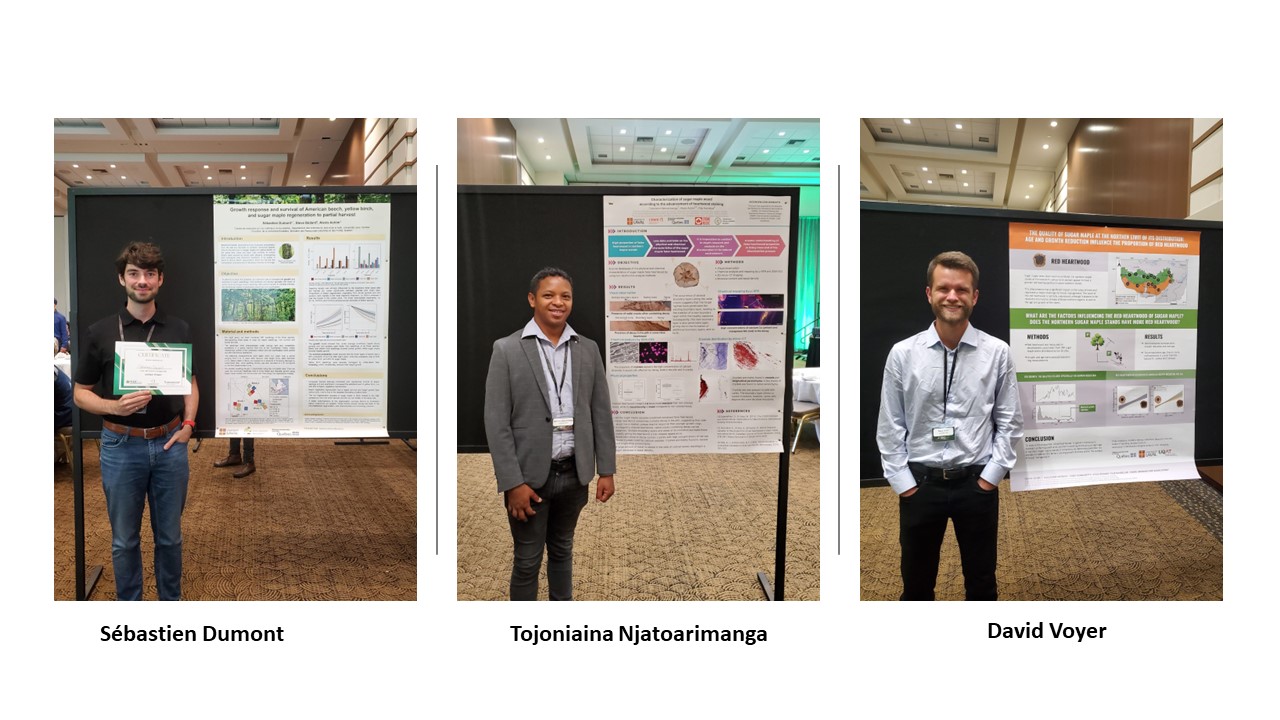Participation of David Voyer, Tojoniaina Njatoarimanga and Sébastien Dumont in the «2023 Northern Hardwood Conference »
At the «2023 Northern Hardwood Conference », held August 1-3, 2023, at the Fredericton Convention Centre, New Brunswick, David Voyer, Tojoniaina Njatoarimanga and Sébastien Dumont, three students under the supervision of Professor Alexis Achim, presented their research results at a poster session.
It was an excellent opportunity to share their experiences, broaden their fields of expertise and network by exchanging with various speakers. Well done to all three of you, and congratulations to Sébastien Dumont and Tojoniaina Njatoarimanga, who won 1st and 3rd poster presentation prizes respectively!
The CRMR is very proud of all of you and we wish you every success in your research careers!

David Voyer is a doctoral student in forestry sciences, under the supervision of Alexis Achim.
Title of the poster: The quality of sugar maple at the northern limit of its distribution
Summary: Red heartwood is a defect that negatively impacts the aesthetic quality of sugar maple and reduces the value of sawn products. In the balsam fir-yellow birch bioclimatic domain, which represents the northern limit of sugar maple stands, red heartwood appears to be of greater importance than in the sugar maple-yellow birch domain. This has raised concerns among foresters about the management of sugar maple stands in the former domain. To investigate the relationship between red heartwood, climate, growth, and age, several hundred sugar maples were sampled in these two bioclimatic domains. The hypotheses were that red heartwood is more common in old trees with low growth, as well as having a higher prevalence in the balsam fir-yellow birch bioclimatic domain. The results showed that red heartwood is strongly associated with tree age and with an indicator of the strongest tree growth decline. Moreover, for the trees of an equivalent age, the proportion of red heartwood was higher in the balsam fir-yellow birch domain. These findings suggest that management should prioritize maintaining continuous growth to limit the occurrence of red heartwood. However, in the context of global change, further analysis is needed to determine the impact of climate change on growth.
Tojoniaina Njatoarimanga is a master’s student in wood and bio-based materials engineering, under the supervision of Alexis Achim (UL) and Filip Havreljuk (MRNF).
Title of the poster : Characterization of sugar maple wood according to the advancement of heartwood staining
Abstract: The aim of this study was to examine the coloration of sugar maple (Acer saccharum Marshall) false heartwood. Special attention was paid to the study of mineral inclusions and their distribution in cells. These studies were performed using non-destructive methods such as micro-X-ray fluorescence (µ-XRF), scanning electron microscopy with energy dispersion spectroscopy (SEM-EDS) and micro computed tomography (micro-CT). The results showed the presence of false heartwood in all samples, sometimes with decay or rot in pith. Radial cracks were also observed, and cells near the cracks also showed decay. Multiple boundary layers and discoloration around these cracks give the false heartwood its starry appearance. Cells containing decay showed crystals with a high concentration of calcium, probably calcium oxalate. These crystals were mainly located on vessels and longitudinal parenchyma. In addition, significant differences in moisture content between colored and non-colored wood were also observed. The moisture content of colored wood was 1.4 times higher than that of non-colored wood. However, this high moisture content affects basic density. Colored wood has a slightly lower basic density than non-colored wood. These results suggest that coloration affects the chemical and physical properties of sugar maple.
Sébastien Dumont is a master’s student in forestry science, under the supervision of Alexis Achim (UL) and Steve Bédard (MRNF).
Title of the poster: Growth response and survival of American beech, yellow birch, and sugar maple regeneration to partial harvest
Abstract: In northern hardwood stands, silvicultural treatments aimed at regenerating sugar maple and yellow birch, such as site preparation and mechanical control of American beech saplings, often results in the formation of dense thickets of beech regeneration. The objective of this study was to compare the growth and survival of three types of beech regeneration, namely stump sprouts, root suckers and seedlings, with that of yellow birch and sugar maple regeneration in partially harvested stands under cervid browsing pressure. Over an eight-year period, 997 individuals of the three species were monitored in three northern hardwood stands dominated by sugar maple, yellow birch, and American beech in Quebec, Canada. Each stand included replicates of four partial harvesting treatments and a control, providing a gradient of light and competition conditions. Beech stump sprouts and root suckers had higher growth and survival than seedlings of all three species under every studied conditions. Results suggest that treatments triggering beech sprouts should be applied with caution and under conditions that ensure sufficient survival and development of desired species. This study also provides evidence of selective browsing by cervids as a significant factor exacerbating the effect of beech competition on yellow birch regeneration.

